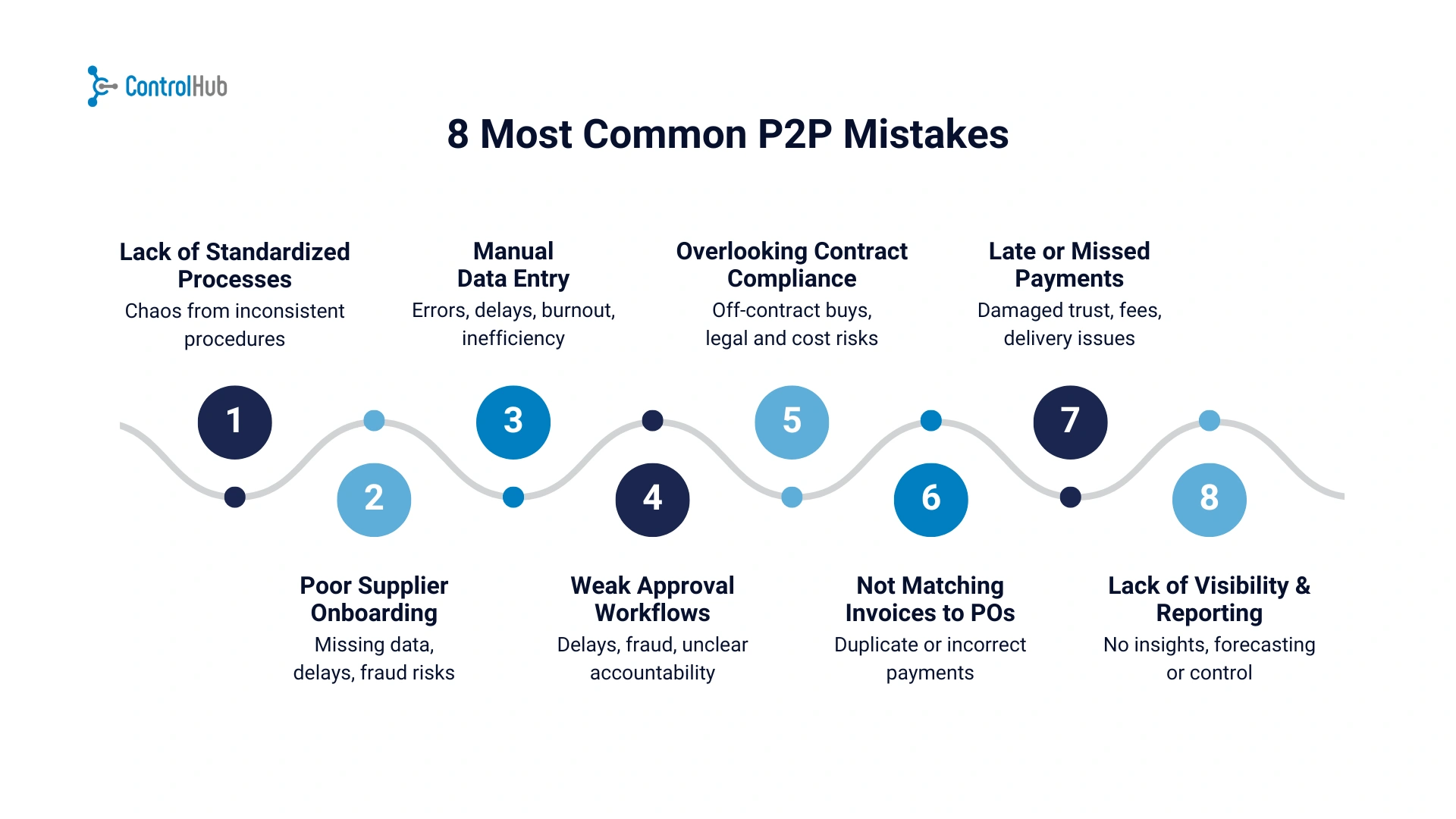Free Supplier Risk Scorecard Download
Download our free supplier risk scorecard here!
Download the free tool!AI Summarize:
In an ideal world, things should work like this: A company decides to buy something, finds a decent supplier, signs an agreement, a PO is created, goods are received, and payment is handled.
Pretty straightforward
Well, sorry to say this, but we are far from working in an ideal world, and anyone who is involved in P2P operations knows that there's no shortage of challenges.
Sometimes it's the market going crazy.
Others?
It's a mistake you didn't notice until it was too late.
Constant errors in P2P processes can represent a tangled mess of delays, manual workarounds, and “wait, who approved this?” moments.
But before you start feeling guilty…
Have the confidence that those problems can be fully prevented if you implement the right approach.
This is how
8 Most Common P2P Mistakes
1. Lack of Standardised Processes
This one deserves a top place in the list due to how common it is.
When everyone on your team follows their own version of the process, you don’t actually have a real working process.
Maybe someone’s using an old PO form saved to their desktop, while someone else prefers sending requests via a phone call.
Approvals might go through three layers in one department but bypass completely in another.
And the result?
Pure chaos and people feeling constantly stressed
This kind of informal setup usually starts off harmless, nothing wrong with doing things fast and a bit messy when you are only starting to build your products.
Until… suddenly, nobody knows who’s responsible for what, requests go missing, and you don't really have a clue what's going on.
The consequences:
- Incomplete or incorrect data that delays approvals and payments
- Orders made without proper authorisation
- Missed opportunities for cost control or contract compliance
- Absolute madness during audits
How to avoid it:
Believe it or not, preventing your P2P operations from going rogue starts with a simple step: Defining what you want the process to look like.
From the moment the need arises to payment terms and methods, make sure everything is written down in a simple and accessible format.
Then, align your procurement and AP teams so they’re on the same page about who does what and when.
Use workflow tools or a P2P platform that makes consistency something anyone can follow.
2. Poor Supplier Onboarding
There's no such thing as a successful procurement strategy if you can't rely on fully vetted and ready-to-work suppliers.
A part of that?
Goes into how well your supplier onboarding process is doing
If you haven't thought much about it, this is the sign that needs to change ASAP.
After all, poor onboarding practices can bring huge problems to your business.
Maybe someone skips collecting tax info, forgets to confirm banking details, or just adds a supplier to the system based on a name in an email. No checks, no validation, no formal record of what was agreed.
Just pure blinding ignorance
The consequences:
- Payment delays due to missing or incorrect details
- Compliance issues if you’re working with unapproved or unvetted people
- Duplicate suppliers
- Risk of fraud, especially with fake or manipulated bank account information
How to avoid it:
Take a look at how your current suppliers are doing. Is there anything you'd like to change? Any information you wish you'd have shared beforehand?
Well, why don't you include that in your onboarding?
Consider working with a form that captures everything you need: legal name, tax ID, payment terms, banking details, and key contacts.
Require supporting documentation and validation before anything goes into your system.
Want to go a step further?
Choose a supplier vendor management platform that gives you the opportunity to automate the whole process and includes built-in checks (e.g., duplicate detection, bank account verification, blacklist screening). It saves your team time, reduces errors, and keeps your supplier data clean and compliant.
3. Manual Data Entry and Paper-Based Invoices
Is your team still typing invoice details into a system by hand?
Do your days include printing, scanning, and emailing PDFs back and forth?
Congratulations
Your P2P processes are definitely outdated.
Now, it's true that manual data entry might seem manageable at low volumes, but it becomes a nightmare the moment things scale. It’s slow, prone to mistakes, and makes everyone feel close to burnout.
Plus, let’s be real, paper invoices and spreadsheets don’t really do much in a process that’s supposed to be traceable and auditable.e
Consequences:
- Typos in key fields like invoice numbers, amounts, or supplier names
- Lost or misfiled invoices
- Duplicate payments or mismatched records
- Longer processing times, which can lead to late fees or missed early payment discounts
How to avoid it:
A single word: Technology
Get yourself acquainted with tools that can scan and extract data from invoices using OCR (optical character recognition), or better yet, move toward true e-invoicing where suppliers submit structured digital invoices directly into your system.
4. Weak Approval Workflows
Nobody likes to send a dozen communications and sit to wait when there's a need that must be covered urgently.
Approval workflows can make or break your P2P process. When they’re unclear or too rigid, chaos follows.
Consequences:
- Delayed orders, missed opportunities, or project hold-ups
- Purchases made without proper review or budget checks
- Higher risk of fraud or unauthorised spend
- A lack of accountability, nobody knows who signed off on what
How to avoid it:
Begin with the basics.
Outline how your approval workflow should work. Who must be included? What's the fastest way to reach them? What's the timeline?
Ideally, use a system that automates routing based on pre-set rules and sends reminders or escalations when approvals stall. That way, no one has to chase manually, and the process keeps moving even when someone’s out of office, which nowadays is pretty common.
5. Overlooking Contract Compliance
When contract terms aren’t actively linked to your purchasing process, it’s easy for teams to buy off-contract, ignore agreed pricing, or miss critical obligations like volume commitments or renewal deadlines.
This usually isn’t malicious; it just happens when contract data isn’t accessible at the point of purchase.
But that disconnect between procurement and contract management costs more than you might think.
Consequences:
- Paying higher rates than what was negotiated
- Inconsistent supplier performance or delivery terms
- Legal and audit risks if obligations aren’t met
- Wasted time and money
How to avoid it:
Connect your contract management approach to a P2P platform so it's not only easier for your team to access, but it's also simpler to discover and understand key terms the moment you need them.
Don't remember very well when some of your contracts expire?
No worries, the right platform will allow you to set up reminders so you never lose track of what's important.
6. Not Matching Invoices to POs
Yes, paying your invoices on time is crucial.
That doesn't mean, however, you should rush to pay for something you've not corroborated yet.
Because what if what you received isn't what you ordered? Maybe you agreed with the supplier on a certain price, and now you are seeing a different amount on the invoice.
Whatever the reason, don't skip carrying out a 3-way matching process
Consequences:
- Paying for items that were never received
- Duplicate or inflated invoices slipping through
- Budget overruns due to unflagged price changes
- Limited ability to challenge suppliers on discrepancies
How to avoid it:
Make 3-way matching a standard, and an automated step in your AP process. The idea is simple: the invoice should match both the PO and the receiving record. If all three line up, great, go ahead and pay. If not, it's time to take a pause and see what happened.
7. Late or Missed Payments
Paying suppliers is key to not only keeping your business in good shape but also to maintaining long-term relationships with suppliers.
But…
How can you pay for something you don't remember?
What if you still haven't received the approval?
You’d think paying invoices on time would be easy, but when the P2P process is disconnected, due dates get missed more often than you'd expect.
Consequences:
- Strained supplier relationships and reduced trust
- Late fees or lost early payment discounts
- Credit holds, which can delay future deliveries
- Endless problems for AP and procurement teams trying to fix things last-minute
How to avoid it:
Use reminders, dashboards, and payment scheduling tools
8. Lack of Visibility and Reporting
You can’t manage what you can’t see, and unfortunately, a lot of P2P teams are still doing things blindly.
When procurement has one view, finance has another, and suppliers are in the dark, it’s impossible to get a clear picture of what’s actually going on.
Are we overspending in certain categories? Where are approvals getting stuck? How much do we owe this month? Without real-time visibility and reporting, answering these basic questions becomes impossible.
Consequences:
- Inability to forecast cash flow accurately
- Missed opportunities to consolidate spend or renegotiate contracts
- No insight into team performance or process efficiency
- Struggles during audits due to missing or inconsistent data
How to avoid it:
Choose P2P software with dashboards and customizable reports
Free Supplier Risk Scorecard Download
Download our free supplier risk scorecard here!
Download the free tool!Free Supplier Risk Scorecard Download
Download our free supplier risk scorecard here!
Download the free tool!Free Supplier Risk Scorecard Download
Download our free supplier risk scorecard here!
Download the free tool!Free Supplier Risk Scorecard Download
Download our free supplier risk scorecard here!
Download the free tool!Key Takeaways
Standardise your process — Consistency is your best defense against errors, delays, and compliance gaps. Document your workflows and stick to them.
Get supplier onboarding right — A clean vendor setup from the start saves time, prevents payment issues, and reduces risk.
Automate where it counts — Manual data entry and paper invoices are slow, error-prone, and outdated. Invest in tools that streamline the basics.
Fix your approval workflows — Clear, role-based, and automated approvals keep things moving without compromising control.
Don’t ignore contract compliance — Contracts only deliver value when they’re actually used. Make sure they’re visible and linked to purchasing activity.
Use 3-way matching as a standard — It’s not red tape — it’s your safety check against overpayments and fraud.
Pay on time, every time — Late payments hurt your reputation and cash flow. Set reminders, schedule payments, and fix bottlenecks.
Get visibility you can act on — Real-time reporting and alerts help you catch problems early, optimize spend, and stay audit-ready.
%20(1).avif)















.png)


